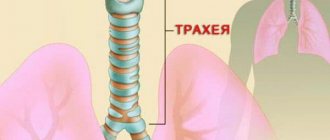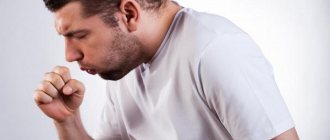Why does a whistling cough occur?
Diseases that cause this condition are characterized by severe irritation of the mucous membrane of the respiratory tract, significant difficulty in the passage of air through them, and severe bronchospasms.
Due to all this, a wheezing cough develops. Usually sputum still forms, but it may not be able to come out. The lumen of the respiratory tract narrows greatly and air has difficulty leaking into the narrowed opening. That's why the characteristic sound arises.
The whistling cough is paroxysmal in nature, completely exhausting the patient. It becomes difficult for him to breathe, wheezing is heard in his chest. After long and difficult efforts, a person sometimes manages to produce a small amount of sputum, but this rarely makes him feel better.
Causes associated with diseases
The symptom clearly indicates the severity of the patient’s condition. The reasons for its occurrence are usually:
- Bronchial asthma;
- pharyngitis;
- tracheitis;
- laryngitis;
- bronchitis;
- allergic reaction;
- whooping cough;
- false croup;
- entry of a foreign object into the respiratory tract;
- stenosis;
- malignant neoplasm;
- tuberculosis;
- anaphylactic shock;
- pulmonary edema;
- injury;
- pneumonitis;
- diphtheria, etc.
Most often, these diseases cause a wheezing cough. Symptoms may vary for different pathologies.
With severe allergies, sometimes reaching anaphylactic shock, significant swelling occurs with the release of inflammatory exudate into the lumen of the bronchi. This makes it so difficult to breathe that the patient simply does not have enough air, which provokes characteristic wheezing.
This condition requires urgent medical attention. When emergency measures are taken, it goes away quite quickly. Read here on how to distinguish an allergic cough from any other and what medications to take.
An attack of bronchial asthma most often occurs at night, during sleep. The person coughs strainedly, trying to free himself from the difficulty that has arisen. But he fails to do this for a long time, until the spasm goes away on its own or the patient takes the medications prescribed to him.
Occasionally, a small amount of secretion may be discharged, which usually does not bring relief. During bronchospasm, a dry cough with a whistling sound when inhaling is characteristic.
Whooping cough is generally considered a childhood disease, but sometimes adults also suffer from it. In this case, the manifestations of this infection greatly torment the patient.
Typically, a wheezing cough with wheezing on exhalation does not occur at once, but is a whole series of attacks. Based on this feature, the doctor usually makes a conclusion about the presence of this disease.
When does a wheezing cough appear?
A whistling cough can affect both adults and children. In the latter, this symptom is especially severe. The reasons for this may be different, but most often it is a side symptom of bronchitis or even asthma. A wheezing cough can lead to many serious illnesses.
One of them is whooping cough. When pathogenic bacteria and other infections enter the respiratory tract, they begin to actively multiply, affecting ever larger areas. Severe inflammation and swelling occurs. Whooping cough can be identified by the following symptoms:
- Convulsive cough, which comes in attacks and is accompanied by whistling when inhaling and wheezing when exhaling. In practice, this looks very frightening: as if the patient is suffocating;
- As with many diseases, the temperature rises;
- The face, particularly the skin around the eyes, swells.
Under no circumstances should you self-medicate whooping cough. It is necessary to urgently consult a doctor. He will prescribe a comprehensive treatment, prescribing drugs that block bronchospasms, antibacterial and mucolytic. In this case, only drug treatment will help, without any folk remedies.
In particularly severe cases, tranquilizers and hormones are prescribed.
Treatment
This serious condition makes the daily existence of the patient very difficult and deprives his family members of peace.
Typically, a whistling cough in such cases is very loud and lasts from several weeks to a month or more. It especially disturbs the patient's relatives at night.
A person may be completely incapacitated. Therefore, often, trying to get to work as quickly as possible, he tries with all his might to help himself on his own. Under no circumstances should this be done.
If you have a wheezing cough, immediate consultation with a doctor is mandatory. The patient cannot accurately diagnose himself, and the uncontrolled use of various medications will make his condition even more severe.
Drug therapy
Usually the doctor prescribes:
- Bronchodilators;
- anti-inflammatory drugs;
- antibiotics;
- sulfonamides;
- antispasmodics;
- antitussives;
- mucolytics;
- expectorants;
- antihistamines;
- external medications that soften the throat;
- inhalations, etc.
It is important to ensure that the person does not lie in one position, but turns over from side to side.
This is required so as not to create an accumulation of secretions in one place in the respiratory tract. The patient is required to drink plenty of fluids, preferably with the addition of soda and alkaline mineral water. This helps dissolve mucus and remove it. A complete list of expectorant drugs and recommendations for their use can be found here.
The human condition must be constantly monitored. If you do not provide him with urgent assistance and do not monitor the intake of prescribed medications, pulmonary edema may develop due to severe respiratory failure.
In addition, it must be remembered that at this time the brain and other tissues experience a severe lack of oxygen, and significant congestion occurs in the pulmonary circulation. For elderly patients or people suffering from diseases of the heart, blood vessels and lungs, this can be dangerous.
Treatment with folk remedies
Home recipes cannot replace treatment with pharmacological drugs, but they can significantly improve the patient’s well-being and speed up the recovery process.
These funds require the approval of a specialist. Only a doctor can make an accurate diagnosis and decide which substances will be useful to a person and which will harm.
A whistling cough accompanies quite severe illnesses, so you need to use this or that medicine very carefully.
The following proven treatments are commonly used:
- Using licorice. It is a proven antitussive. A tablespoon of raw material is brewed in a glass of water, and after cooling, a teaspoon of honey is added. You should take a third of a glass of the drink before each meal. The treatment period for dry cough usually lasts seven days.
- If you have a fever, you should use ginger. It is scrolled through a meat grinder and infused in a thermos for half an hour. Then the drink is allowed to cool and a teaspoon of honey is added to it. Take three times a day.
- Onion and honey will help reduce the intensity of a dry cough. The onion must be turned through a meat grinder, strain off the juice, add a tablespoon of honey and leave for an hour. Take twice a day.
- A very effective remedy for this condition is considered to be warm milk, to which butter and honey are added. You need to drink it every time an attack develops.
- Steam inhalations have worked well in the absence of elevated temperatures. You can add spruce or pine needles, soda or various plant substances to boiling water. After the procedure, you should immediately go to bed and cover yourself warmly to avoid catching a cold. They should be done at least ten times.
Causes
The cough appears both at the beginning of the disease and persists for a long time after recovery.
A wheezing cough exhausts a person, and regular attacks appear at inopportune moments. Children especially suffer at night while sleeping. It is impossible to clear the throat completely; short-term relief does not improve the patient’s condition. Lack of timely treatment can lead to serious complications and even death.
According to doctors, before prescribing therapy, it is necessary to find out the causes of wheezing cough. The symptoms that accompany wheezing help make a diagnosis and begin treatment. Diseases that cause whistling cough:
- Asthma. People suffering from asthma attacks try to clear their throat. But the cough cannot be eliminated until the patient takes the right drug that relieves the spasm. Asthma is characterized by a dry barking cough, discomfort in the neck, and a sharp blue discoloration of the nasolabial triangle.
- Whooping cough. It most often appears in children, but in rare cases it is diagnosed in adults. In addition to whistling in the bronchi, fever, lacrimation and swelling of the eyelids, and runny nose are added.
- Allergy. Swelling of the airways is often accompanied by the release of exudate into the bronchi. An allergic reaction makes it difficult to breathe. The person does not have enough air, and a heavy breath produces a whistle.
- Bronchitis. Coughing with a whistling sound is aggravated by poor health, shortness of breath, sometimes high fever and sweating. A wheezing cough worsens when exhaling slowly after a deep breath.
- Foreign body. A sudden whistling sound when coughing and exhaling, a pale or already blue face, a rapid heartbeat means that a small object has entered the respiratory tract. Parents need to be careful to ensure that the child does not put anything in his mouth or nose. If similar symptoms appear, you should call an ambulance.
- Oncology. New growths in the body can cause narrowing of the bronchi and the release of sputum interspersed with blood.
A whistling cough sometimes occurs with stenosis, laryngitis, false croup, measles, diphtheria and tuberculosis. You cannot put off visiting a doctor at a specialized medical center. Until the diagnosis is clarified, it is dangerous to self-medicate.
Features of the treatment of wheezing cough in a child
Every person on Earth has coughed at some point. Cough is a natural reaction of the body to irritants of the upper and lower respiratory tract. Just like sneezing, coughing up excess phlegm and mucus in moderation is good for your health. But sometimes this process can get so bad that it becomes a problem itself.
Characteristic signs
From the first days of their baby’s life, mothers learn to distinguish the slightest shades of his breathing, movements, gaze and even cough. They know that sharp guttural exhalations can be different. Some occur randomly, do not cause visible discomfort and last a short time. But others may be accompanied by stale breathing, a characteristic whistle and continue throughout the whole night.
A wheezing cough in a child has different causes. It happens that a child’s breathing, even without coughing, comes with a whistling sound. Sometimes, on the contrary, too much sputum is produced. And some types of wheezing cough are the initial signs of cancer - throat cancer.
The video shows the nature of a wheezing cough in a child:
Causes
The very first suspicion that an ENT doctor has about the cause of a wheezing cough is bronchitis. Most often obstructive bronchitis. It is expressed in damage to the mucous membrane not only of the larynx, but also of the deeply located bronchi. The cause of their damage may be viral infections, fine dust, allergens or pathogenic bacteria. Causes:
- Pharyngitis is also a very popular cause of whistling when coughing and sharp exhalations. In this case, bacteria or viruses affect the upper respiratory tract. Epithelial cells in the larynx begin to die from exposure to harmful microflora. They are the cause of whistling when coughing and difficulty breathing with pharyngitis.
- A cold can be expressed not only by high fever and expectoration of phlegm, but also by a wheezing cough. My throat feels sore, it feels like there is sandpaper inside, I want to drink water to relieve the dryness. In such cases, you need to constantly take expectorant mucolytic drugs. They will allow the mucus to become more liquid and remove harmful microorganisms from the throat. Naturally, when carrying out complex treatment affecting the cause of the disease.
- Whooping cough . A long whistling breath ending in an unpleasant cough is the result of the effect of the whooping cough bacillus on the nerve center of the cough. The main feature of this type of cough is the almost complete absence of sputum.
- An attack of bronchial asthma . It appears for the same reasons as shortness of breath. These are allergens, increased physical activity, dust in the room, a nervous reaction to light, sound or heat. Depending on the form and severity of the asthmatic syndrome, sputum may be completely absent or present in excess.
- Throat cancer . Sometimes a dry cough with a whistling sound can be a harbinger of the terrible disease of our age, throat cancer. In this case, it is extremely important not to miss the initial symptoms in order to begin treatment as early as possible.
The video talks about whooping cough as the cause of a dry wheezing cough in a child:
Treatment of children
Since the main cause of a wheezing cough in humans is a viral or bacterial infection, an antibiotic seems to be the ideal medicine. But we must remember that cough suppressants are divided into children’s and adults’, not only because of their dosages. There are also other features and differences between the methods and means of treating difficulty breathing and coughing with whistling in adults and in children.
How to alleviate the disease
The title includes the word “relieve”, not cure. A child, especially one of preschool age, is unlikely to be able to accurately describe the symptoms that accompany his cough. And since there can be many reasons for it, the diagnosis should be made by a pediatrician or attending physician. Mom can only contribute to the main treatment of the very cause of the wheezing cough. There are several recommendations for this.
Read how to cure a barking cough in a child.
Approximate prices for Geksoral tablets: https://prolor.ru/g/lechenie/geksoral-tabletki-dlya-rassasyvaniya-instrukciya-po-primeneniyu.html.
Here you can read the instructions for using Bioparox for children.
Inhalations
Some of us still remember the popular treatment for colds in the form of “steam baths” over a pan of potatoes. In some cases, this practice can also eliminate whistling during shortness of breath. Hot air, saturated with steam and soft starch, causes rapid development of mucus. Sputum begins to come out abundantly, and the cough moves from “dry” to “wet”. The link describes how to properly breathe through potatoes when coughing.
Soda inhalations perform the same function. They thin out mucus, allowing the child to breathe and cough more freely. This makes the course of the underlying illness easier and sometimes is the only way to survive until the morning and sleep!
Expectorants
If you have not yet reached your doctor and he has not diagnosed you, it is not advisable to rely heavily on antibiotics. And this rule is ten times more relevant when it comes to children's health. Even seemingly similar symptoms in different family members can be the result of different diseases.
In the photo - the expectorant drug Gerbion:
However, every mother is obliged to relieve her child’s hysterical cough. There are mucolytic drugs for this. They have an expectorant effect. This manifests itself in the fact that the whistling and, as it were, forced cough becomes calmer and lighter. The purpose of expectorants is that they facilitate the flow of air through the larynx and bronchi. Less effort is spent on inhalation and exhalation, and the chest and muscles associated with breathing relax. The link describes expectorants for dry coughs for children.
Medicines for bronchial asthma
The relief of sudden and frequent attacks of bronchial asthma should be planned exclusively by the attending physician. The most common and accessible drugs are:
- salbutamol
- berodual
- fenoterol
- Terbutaline
In some cases, they may be prescribed for the treatment of obstructive bronchitis. The symptoms and treatment of obstructive bronchitis in children are described here.
Natural preparations
Some expectorants contain exclusively natural ingredients. For example, substances such as Adhatoda vascularis and Peppermint can make the cough more “wet.” In principle, this is not so much a medicine as a means to relieve symptoms and allow you to breathe calmly. Such drugs must be used in combination with other treatment for the causes of wheezing cough and the underlying disease that caused it.
In the photo - natural cough syrup Linkas for children:
Help for an adult
As in children, in adults a wheezing cough can be the result of an allergic reaction. In any case, be it a manifestation of bronchial asthma or seasonal irritation, you need to consult your doctor. He will give recommendations for treating the cause, and so that you can at least speak and breathe normally, he will recommend safe and effective medications.
Antibiotics and mucolytics are a standard set for the treatment of wheezing cough. But depending on the types of viruses, one or another drug will be recommended. It is also necessary to know about the individual characteristics of the body and its interaction with a particular antibiotic. This will avoid complications.
Traditional methods of treating dry cough often give good results. For example, badger fat perfectly cleanses the throat and bronchi. It is enough to take one teaspoon per day on an empty stomach. The use of badger fat for coughing is described here. Radish with honey is also good for coughs.
Or a honey diet that accompanies every meal. A person can eat everything the same as before, but honey is added to the usual menu. It allows you to get rid of colds, dry coughs and is even recommended for bronchial asthma.
A wheezing cough can only be treated in relation to the cause of its occurrence. After all, it can indicate various diseases. Either a relatively simple cold, or the first symptoms of a terrible throat cancer. Therefore, if you or your child have a dry cough with whistling for the first time, you should immediately go to the clinic.
If this is not the first time that such a cough has brought trouble into your life, then you need to consult a doctor about antibiotics and traditional methods that can be used to treat it. Inhalers and sprays are often the only way to ease breathing at work and on the street.
ProLor.ru
How to treat
Treatment of wheezing cough is carried out comprehensively.
A combination of medications can get rid of the disease in a short time. Typically, therapists prescribe:
- expectorant;
- anti-inflammatory drug;
- bronchodilator;
- antibiotic;
- mucolytic;
- throat soothing medications;
- antihistamine.
If the cough is not accompanied by a high temperature, the therapist or pediatrician will prescribe inhalations. The patient needs to drink plenty of fluids. Alkaline mineral water is suitable for these purposes. The youngest patients are offered weak tea or apple compote.
Traditional methods of treating wheezing cough do not exclude drug therapy. But they speed up the healing process. The disease can be cured using the following recipes:
- Licorice. It is necessary to pour 1 tablespoon of dry licorice (sold in a pharmacy) with 250 ml of boiling water, and after cooling, add a spoonful of honey. Drink before every meal.
- Ginger. Chop fresh ginger root and brew it in a thermos. Add honey to the cooled drink to taste. Give the patient a few sips 2-3 times a day.
- Onion. Squeeze the juice from one onion, add honey. Take a teaspoon twice a day.
- Milk. Warm cow's milk with the addition of melted butter and honey removes mucus from the bronchi well. Doctors advise taking this remedy for every attack of wheezing cough.
- Inhalations with pine needles. Place Christmas tree needles in water with baking soda and boil on the stove. To avoid burning your respiratory tract, do not cover your head with a towel. If your baby is sick, you can put a decoction in the room so that the baby inhales the vapors of the pine needles.
Traditional methods of treatment facilitate the discharge of sputum, soften the throat, strengthen the body's defenses and destroy infection in the body.
In an adult
In the first weeks after recovery, an adult’s cough may persist. If you follow the therapist's recommendations, it will go away within a month. Otherwise, the cough becomes chronic.
An attack of wheezing cough in the middle of the night can cause inconvenience to the patient. If relief does not occur, you should call a doctor. Before the ambulance arrives, you must adhere to the following recommendations:
- The person should take a comfortable position, preferably half-sitting.
- It is necessary to open a window to provide fresh air.
- Next, you need to take an antihistamine to relieve swelling.
- A light massage of the back and chest will ease the condition.
Giving hot tea or warming the throat with a heating pad is prohibited. This can cause swelling and lead to complications.
A severe whistling cough can occur in a smoker. Attacks may be so frequent that it is recommended to reconsider your attitude towards smoking. Lack of oxygen causes darkening of the eyes, attacks of suffocation, and fainting. With each attack it becomes more and more difficult to breathe, the condition worsens.
The child has
To treat a child’s cough, which is accompanied by whistling and dry throat, you need to use special syrups and give warm tea.
Drinking fluids throughout the day helps with coughing. It is not always necessary to suppress a cough in children, because this is a protective reaction of the body.
Prevention of whistling cough
To avoid getting sick often, it is necessary to engage in preventative health care.
The appearance of a cough can be prevented by:
- get into the habit of regular ventilation and daily wet cleaning of the house;
- stop smoking;
- wash your hands more often;
- walk several hours a day in clean air;
- exercise;
- to harden;
- take breaks during the working day;
- eat seasonal fruits and vegetables to replenish the vitamin balance in the body;
- during an epidemic, avoid crowded places;
- eliminate sources of allergens in the apartment;
- drink large amounts of liquid in the form of purified water, juices, fruit drinks, tea.
Coughing, including whistling cough, is a serious danger to the respiratory system. If it does not go away for a long time, you should inform your doctor about it to clarify the diagnosis and prescribe the correct therapy.
Causes and treatment of whistling cough
In most cases, a cough alleviates the patient’s condition by accelerating the removal of phlegm from the bronchi, but under certain conditions (unpleasant sensations, whistling, wheezing), such a manifestation of the disease requires increased attention and adequate treatment. A significant narrowing of the airway lumen poses a particular danger for children. In a child, the bronchioles are small, and any spasms can cause a worsening of the condition.
Possible sources of the pathological condition
A whistling cough usually indicates the rapid passage of air during inhalation and exhalation through the respiratory lumens. The channels narrow due to filling with bronchial secretions or sharp spasms accompanying the inflammatory process. In any case, uncharacteristic sounds during convulsive contractions of the chest require immediate seeking help from specialists from a medical institution (pulmonologist, infectious disease specialist, therapist, otolaryngologist).
What causes dry cough with whistling in adults
Typically, breathing problems are the result of infections or viruses affecting the respiratory system. First of all, the doctor excludes such serious diseases as tuberculosis and pneumonia.
Diseases that cause whistling when exhaling:
- pharyngitis, pulmonary edema;
- diphtheria, stenosis;
- allergic reactions;
- asthma, bronchitis.
The possibility of mechanical damage to the respiratory tract cannot be excluded. Wheezing in the bronchi may indicate a chemical burn or chest injury.
Causes of a frightening symptom in children
Most often, a whistling cough in a child occurs when the lumen is blocked by a foreign body. The therapist will definitely look into the throat to check the correct air circulation in the lungs. Often, spasms occur as a result of the body’s attempts to get rid of the blockage.
In addition, you need to make sure that the spasms are not caused by:
- false croup;
- obstructive bronchitis;
- whooping cough, tracheitis.
In any case, to prevent dangerous complications such as asphyxia or anaphylactic shock, you need to perform a quality examination by a pediatrician,
Wheezing
Wheezing when exhaling
Nothing should interfere with a person’s healthy breathing; it occurs completely calmly and is not noticeable to the person. If the opposite happens, breathing becomes difficult, a whistle appears when exhaling or inhaling, this indicates the presence of a respiratory tract disease. Most often, wheezing occurs during exhalation; this happens due to a narrowing of the lumen of the larynx.
Causes of wheezing
There are many reasons for wheezing, let's look at some of them.
Asthma is an allergic disease. It is constantly present in a person, sometimes it subsides, sometimes it intensifies. If a person has eaten something that he is allergic to, or has taken a breath, he has received allergens in any way. Inflammation appears on the walls of the bronchi, resulting in swelling and narrowing of the lumen, and we hear a loud whistle.
Anaphylactic shock (reaction) is when a person is injected into the bloodstream of some kind of drug to which he is allergic, an insect bite. Immediately after this, shortness of breath appears, breathing through the nose becomes difficult, the person sneezes, swallowing becomes difficult, and a whistle is heard due to the narrowing of the lumen of the bronchi.
If a foreign body enters the respiratory tract, a person could inhale something, and the foreign body enters the lungs or bronchi. As a result, a strong dry cough, whistling, rapid heartbeat appears, the lips and face become bluish, and the temperature rises.
Lung damage occurs due to injury, explosion, or accident. Such damage is very life-threatening and the person urgently needs medical attention. Swelling, difficulty breathing, chest pain, whistling when breathing, and bleeding appear.
Bronchitis is a fairly common disease; a person catches a cold. Inflammation appears in the bronchi, accompanied by coughing, whistling, fever, weakness, and wheezing.
Tracheitis is an inflammatory process in the bronchi and trachea. The symptoms are the same as those of bronchitis, which occurs as a result of a complication of a cold.
Lung cancer, a tumor appears, and it narrows the lumen of the respiratory tract, because of this wheezing appears, as well as coughing up blood, a person quickly gets tired and loses weight.
Treatment of wheezing
You definitely need to see a doctor for an examination. He will determine what kind of disease you have, prescribe effective treatment, and take pictures if necessary. By the way, by the color of sputum, it is easy to determine what disease a person has. If the color of the sputum after coughing is yellow, then this is an infectious disease and requires treatment with antibiotics. As a rule, in such cases, the doctor prescribes drugs to thin and expectorate sputum, these can be syrups, herbal decoctions, tablets. To relieve the spasm, treatment with inhalers, nebulizer breathing, and antiallergic drugs are prescribed.
Wheezing in a child
Wheezing in a child occurs as a result of the accumulation of mucus in the trachea or bronchi due to spasm. It is necessary to observe how the child breathes; a whistle appears on inhalation or exhalation; if on inhalation, this may indicate that a foreign body could have entered the child’s respiratory tract and he urgently needs first aid. If a child develops whistling or wheezing, you need to show him to a doctor to determine the nature of the disease. This may be a sign of asthma, acute bronchitis, laryngitis, or an allergy. The sooner the causes are identified and treatment is started, the faster the disease will recede.
Wheezing in an adult
In an adult, wheezing can occur, just like in a child, as a result of hypothermia or bronchitis. In adults, obstructive bronchitis most often occurs with such breathing. It is influenced by many factors. Such as inflammatory and infectious diseases of the respiratory system. Pneumonia, bronchitis, swelling of the bronchi and trachea, allergies, burns of the larynx, injuries, smoking.
Cough and wheezing
Most often, a cough appears first due to inflammation in the respiratory tract, and only then a whistling sound. Wheezing when coughing is a complication, and no matter what happens to this, you need to consult a doctor in a timely manner and with the right treatment it will not come to this.
kashelb.com
Diagnostic methods
Self-diagnosis is not allowed. At the first suspicion of a worsening condition, you should seek help at the hospital or call an ambulance.
How to determine the possible cause of a dry, nonproductive whistling cough:
- with obstructive bronchitis, chest spasms primarily occur in the morning and soften slightly by lunchtime;
- infections and viruses cause fever, headache, and other manifestations of intoxication;
- Obstruction of the respiratory tract can be suspected by the bluishness of the face, convulsive contractions of the larynx and rapid heartbeat;
- Bronchial asthma and allergies are characterized by lethargy, pale skin, nausea, vomiting, and fainting.
You can confirm or refute your fears by performing a diagnosis at a medical facility. First of all, the doctor will conduct a visual examination of the throat, listen to breathing using a stethoscope, and collect anamnesis (questioning the patient). In order to clarify the causes of a wheezing cough, it is necessary to take blood tests, urine tests (inflammation), and undergo a hardware examination. Most often recommended:
- spirography (method for determining lung volume);
- bronchoscopy (assessment of the condition of the bronchial tree);
- fluorography (exclusion of tuberculosis and other destructive processes).
A whistling cough requires a scratch test, which can identify allergens.
Symptoms
At the beginning, wheezing cough in adults and children is dry and suffocating. With further development of the pathology, wheezing is added to the main symptom.
Depending on the disease that provoked the malaise and coughing, the accompanying symptoms of the pathology may differ slightly:
- The appearance of shortness of breath, wheezing and difficulty breathing through the nose is characteristic of allergic reactions and bronchial asthma. In this case, the condition may be accompanied by paleness of the face, lightheadedness, lethargy, and shortness of breath. After the end of an asthma attack, or removal of the allergen, the patient experiences a withdrawal of bronchial secretions, often accompanied by vomiting, and drowsiness and loss of consciousness are also possible.
- A localized increase in body temperature, as well as the occurrence of pain during coughing, often indicate the presence of respiratory injuries or oncological processes.
- Increased heart rate, increased body temperature, sudden convulsive movements and bluish skin on the face are direct signs of foreign objects entering the respiratory system.
- An increase in body temperature, along with redness or bluishness of the face, swelling of the eyes, headache and vomiting, may indicate infection with measles or whooping cough.
- A severe cough with a whistling sound in the morning, slightly easing by the middle of the day, but occurring mainly during wakefulness often indicates the presence of obstructive bronchitis.
Laryngotracheitis is characterized by hoarseness of voice, barking cough and pain that occurs behind the sternum.
Most often, weak coughing up of sputum, accompanied by a wheezing cough without an increase in body temperature, indicates asthma, bronchial obstruction and allergies.
Examination by a doctor - the initial stage of diagnosis
How to treat wheezing exhalations
Adequate therapy should be prescribed only by a doctor. Self-medication often leads to complications and deterioration of the patient’s condition. General recommendations include bed rest (with a mandatory change in body position to avoid stagnation of sputum), drinking plenty of fluids, taking antipyretic and painkillers (if necessary).
Pharmacotherapy
Medicinal effects must be approved by a specialized specialist.
Many people start taking antibiotics uncontrollably when they have a whistling cough. Such therapy may worsen the patient's condition.
Antibacterial tablets are indicated only when infection of the respiratory system is confirmed.
- mucolytics are necessary to thin the mucus in the bronchi and facilitate the removal of sputum (Ambroxol, ACC);
- bronchodilators (Fenoterol, Salbutamol) are used to increase the respiratory lumen during bronchitis;
- antihistamine tablets are used to eliminate the body’s incorrect reaction to irritants (Cetrin, Loratadine).
During exacerbation of bronchitis, many doctors prescribe sulfonamides (“Sulfadimezin”) to their patients.
Traditional medicine against whistling cough
It is important to understand that natural medicines should be used in combination with classical medications. Traditional medicine recipes cannot independently cope with dangerous diseases that are characterized by a dry cough with wheezing and whistling.
The most common treatment advice found on the Internet is:
- honey with onions (a natural antiseptic destroys bacteria and makes breathing easier);
- licorice root (the plant has antitussive properties and can quickly eliminate chest spasms);
- collecting herbs (chamomile, calendula, mint, sage, thyme can alleviate the patient’s condition).
Steam inhalation with eucalyptus and pine needles shows good results in the treatment of wheezing cough. The main thing to remember is that such procedures are prohibited at high body temperatures.
Treatment of wheezing cough without fever
Pathology therapy involves treating the underlying disease. In this case, the type of drugs must be selected individually, taking into account the age and health status of the patient.
Treatment can be carried out in the following ways:
- Taking medications;
- Application of traditional medicine recipes.
It is worth knowing that traditional methods cannot be used as the main treatment due to low efficiency and a large number of contraindications. Their use is possible only in the form of auxiliary therapy. However, before using traditional recipes, it is important to consult a doctor.
Salbutamol is a drug from the group of bronchodilators
Medication
To treat pathology caused by a narrowing of the lumen of the bronchi and accompanied by a cough without fever and rare minor coughing, drugs from the following groups can be used:
- Bronchodilators. Allows the bronchi to expand. These include the drugs Terbutaline, Salbutamol, Fenoterol;
- Antihistamines. Block the body's response to the allergen. Allerzine, Eden, Loratadine, Cetrin and Fexofenadine are commonly used.
- Mucolytics. Necessary for thinning sputum and facilitating its removal. Ambroxol, Bromhexine and ACC are usually used;
- Sulfalamides. Used for acute obstructive bronchitis. The most commonly used are Sulfadimethoxine and Sulfadimezine. However, they should not be taken without medical supervision, since drugs in this group can have a strong toxic effect on the body’s protein structures in the blood.
Broad-spectrum or narrow-spectrum antibiotics are used only when there is a bacterial infection in the body.
Sulfadimethoxine is used for acute obstructive bronchitis
Traditional ways
Traditional medicine recipes cannot be used to treat wheezing cough caused by allergies, bronchial asthma, anaphylactic shock and pulmonary edema. Such conditions require urgent medical attention and the use of antihistamines, and sometimes resuscitation agents.
Traditional methods of treating whistling cough involve inhalation and ingestion of herbal decoctions:
- Add 1 tsp to 200 ml of boiling water. dry chamomile, calendula flowers and eucalyptus leaves. The mixture is simmered over low heat for 3-4 minutes. Then the broth must be left for 30 minutes and strained. Dilute the resulting medicine with boiled water to a volume of 400 ml and take 50 ml orally 2 times a day 20 minutes before meals. The course of treatment lasts 5-7 days.
- 15-20 minutes before bedtime, drink 100-150 ml of warm milk with 1 tsp diluted in it. honey
- Add 1 tsp to 2 liters of boiling water. medicinal chamomile, thyme, sage, eucalyptus leaves and soda. Remove the container from the heat and perform steam inhalation. To do this, the patient needs to bend slightly over the container with the decoction and cover the head and the container itself with a large towel. You need to breathe alternately through your nose and mouth.
Inhalation at elevated body temperatures is unacceptable.
Warm milk with honey is an effective folk remedy for cough
Cough With Whistling (Causes, Treatment)
All children and adults sometimes cough. This pathology is not an independent ailment. This is usually evidence that the inflammatory process has penetrated deeply into the respiratory organs.
A cough with a whistling sound can indicate very serious illnesses, and not always that a person has a cold or has contracted the flu.
Whistling breathing usually exhausts the patient. This condition cannot be ignored. It is important to urgently take measures to eliminate this manifestation in the body.
Causes of wheezing cough
Before you begin to treat such a cold symptom, you need to understand why exactly a whistling cough appears in adults, the reasons for this manifestation. Doctors say that most often the culprits are obstructive processes developing in the respiratory organs. It is possible to determine for sure which disease caused this alarming symptom only after a thorough examination, therefore, if a wheezing cough appears, you should seek medical help immediately.
Reasons that can trigger a cough accompanied by whistling:
- whooping cough
(the temperature may further increase and swelling of the eyes may appear); - bronchitis
(manifests itself as shortness of breath, coughing and wheezing); - asthma
(the nasolabial triangle turns blue, unpleasant irritation is felt in the neck and chin area).
Another disease against which this unpleasant symptom can manifest itself is measles. All of these diseases are serious and can have serious consequences, so in no case should you begin treatment until an accurate diagnosis is made.
Causes of whistling cough
This state of the body usually makes itself felt when an excessive amount of mucus accumulates in the lumen of the respiratory tract, namely in the bronchioles. By clogging the gaps, it makes breathing difficult.
Attacks of such coughing usually last half an hour to an hour. Insufficient oxygen supply is very debilitating. A coughing person may experience dizziness, blurred vision, and sometimes even lose consciousness.
The symptom is quite severe. A child’s cough like this is a particularly dangerous phenomenon. After all, his bronchial branches are already narrowed.
A dry cough with a strong whistle develops as a result of bronchial asthma, bronchial obstruction, laryngeal stenosis and tracheitis. It is this condition that is a manifestation of these pathologies. But it could also be for another serious reason.
To successfully cope with a wheezing cough, you should know why the reasons for its manifestation arose. Only in this case can the proper therapeutic effect be achieved.
A whistling cough may appear in particular with the following pathologies:
Bronchitis
It most often makes itself felt with a whistling cough. In addition, the patient experiences shortness of breath and other symptoms:
Therapy is aimed mainly at relieving spasms in the bronchi and stopping the inflammatory process. The additional use of folk methods in the form of inhalations and rinses to calm the cough also has a good effect.
Whooping cough
The disease occurs when the respiratory tract becomes infected with pathogens. Actively multiplying, they affect increasingly larger areas, causing inflammation and swelling. Whooping cough makes itself felt with the following signs:
- convulsive cough with whistling on inhalation and wheezing on exhalation, which creates the impression that the patient is suffocating;
- increased temperature;
- swelling of the face, especially around the eyes.
Asthma
A wheezing cough can also occur with such a serious illness as bronchial asthma. The pathology refers to allergic manifestations and is characterized by rather complex therapy.
It is usually passed on by inheritance. But it can also be an acquired disease. For example, as a consequence of untreated bronchitis.
The picture of the development of a disease such as asthma in adults and children is common.
Its characteristic symptoms appear:
- shortness of breath;
- breathing and coughing with whistling;
- burning sensation in the chest, as well as in the chin and neck area;
- blueness of the nasolabial triangle area.
They treat illness in the hospital and at home. This mostly happens at home, as therapy takes a long time.
A wheezing cough can also occur for other reasons, including the entry of foreign objects into the nasopharynx and bronchi. This phenomenon is usually characteristic of young children, who, when playing, often stick beads, buttons, pennies and other small objects into their noses.
Prevention
Following simple rules will help avoid coughing. Necessary:
- Wash your hands frequently with soap to prevent infection with colds and influenza.
- If possible, reduce contact with sick people during epidemics.
- Get rid of bad habits, beware of passive smoking.
If you have any cough, you should increase the amount of fluid you drink.
Coughing is the body’s protective reaction to irritants. Viruses and pathogenic bacteria begin to multiply on the mucous membrane, causing irritation.
A severe dry cough appears, which can deprive the patient of sleep for the entire duration of treatment. But besides this, a cough can appear as a result of inflammation of the respiratory organs.
The causes of cough with whistling are different. It causes quite a lot of distress for the patient, because it is extraordinary.
A wheezing cough is not a common occurrence, but it causes a lot of inconvenience. It greatly irritates the throat and larynx, can cause side diseases such as sore throat and even lead to inflammation of the lungs.
Its characteristic signs are whistling when coughing and wheezing when breathing.
Treatment of whistling cough
If a pathology such as a wheezing cough occurs, you should definitely consult a doctor. Moreover, treatment for a cough in an adult requires a slightly different treatment than a similar pathology in children, although the signs of ailments are common. It is impossible to diagnose yourself, and uncontrolled therapy can only worsen an already serious condition.
High fever during bronchitis, lasting more than 5 days, is treated with antibacterial drugs, as well as sulfonamides, cephalosporins and penicillins.
An integrated approach is used to treat whooping cough. Medicines are selected according to the patient's age and the severity of his condition.
Since asthma is usually provoked by allergies, treatment is carried out with hormonal drugs in the form of sprays, as well as histamines. If the illness does not occur without fever, then we can assume that this is an allergic reaction to some irritant. Insect bites can provoke swelling of the respiratory organs, and, consequently, a wheezing cough, especially if a person is prone to allergies. Only a knowledgeable specialist can decide how to treat a wheezing cough in adults without fever.
You should be especially careful when a child has a dry cough with a whistling sound.
Treatment with traditional methods
Of course, traditional medicine cannot always completely cure the pathology in question, as pharmacological drugs can do. However, her advice can significantly improve the patient’s condition and speed up the process of his recovery. Here are some of them:
Licorice root is a proven remedy for relieving respiratory problems. Whistling when breathing quickly stops and significant relief occurs - 1 tbsp. l. raw materials are poured 1 tbsp. boiling water and brew. After cooling, add 1 tsp. honey and drink a third of a glass before eating. Treatment duration is one week;
Honey with onions also reduces the intensity of cough well - mince the onions, strain the juice, add 1 tsp to it. honey and leave for an hour. Take twice daily; Steam inhalations with spruce or pine needles, soda or medicinal plants are also effective - after the procedure you need to go to bed and wrap yourself up well, but they can be done in the absence of fever.
These methods will make it possible to improve coughing and inhalation. The whistling in the throat will go away, as will the infection, and the body's defenses will become stronger.











